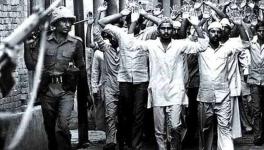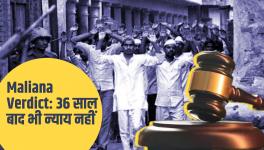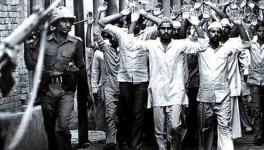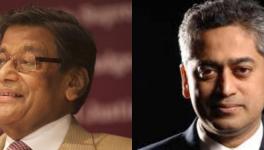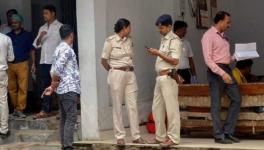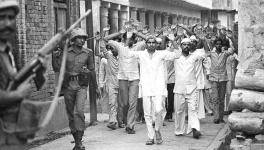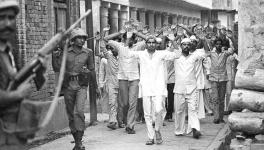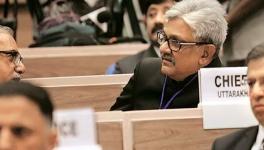Hashimpura Massacre Was a Case of Targeted Killing of Muslims, says Court
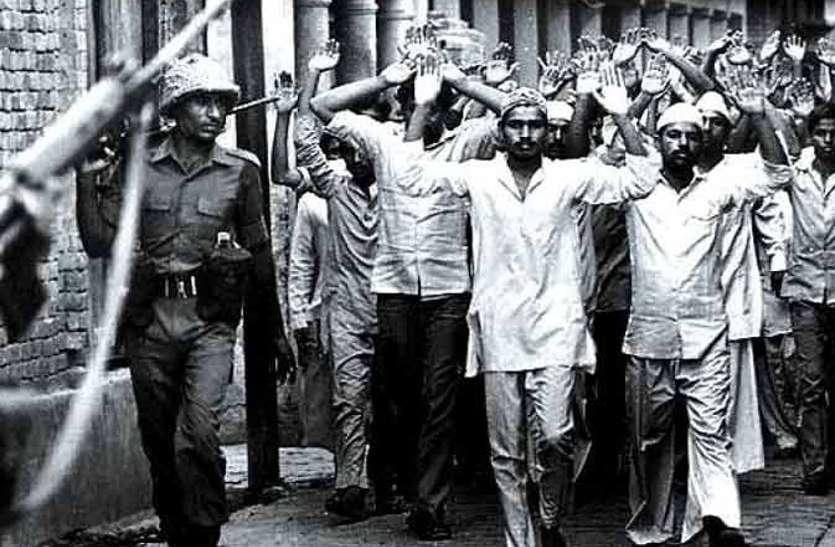
The Uttar Pradesh Provincial Armed Constabulary’s (PAC) personnel’s bone-chilling, cold-blooded massacre of 42 Muslim men and youth on the night of May 22, 1987 has finally been accounted for, after an excruciatingly painful gap of 31 years, with the Delhi High Court on October 31, sentencing 16 surviving accused of the total of 19 to life imprisonment for murder, criminal conspiracy and illegal confinement. In the history of modern India, this case saw the largest number of victims killed in police custody.
In their judgement , Justices S. Muralidhar and Vinod Goel termed the gruesome crime as a targeted killing of members of a minority community revealing an institutional bias within law enforcement agencies, in which the police and investigating agencies were complicit in destroying evidence, trying to wipe out public memory and preventing the victims from knowing the truth.
The high court overturned the trial court judgement of March 21, 2015 delivered by Sanjay Jindal, Additional Sessions Judge in the Tees Hazari Court at Delhi, which, while acquitting all the accused, had held:
“Since there is lack of direct evidence against the accused persons, the case in hand has virtually converted into a case of circumstantial evidence against the accused … despite there being several eyewitnesses. Most of the basic facts except the identity of the culprits have been duly established … but the evidence required to connect the accused persons with the crime is actually missing.”
According to Judge Jindal, the testimonies of five survivor eyewitnesses- Zulfiqar Nasir (PW-1)- who was the appellant before the high court, Mohd. Naeem (PW-2), Mohd. Usman (PW-3), Muzib-ur-Rehman (PW-4) and Babuddin (PW-11)- howsoever concrete and blemishless—were grossly insufficient to nail the case, the killings had to be connected to the accused, for which one would need to prove that those 19 men, using those specific rifles, had used that particular truck in their murderous endeavour. Furthermore, since the maximum punishment upon conviction would either be life imprisonment or capital punishment, nothing but proof beyond reasonable doubt could suffice.
Thus, it is necessary to see how the high court arrived at its conclusion to hold that the trial court ruling could not be sustained in law.
High Court Did Not Re-appreciate Evidence
All the accused personnel of the C- Company of the PAC’s 41st Battalion, the platoon of which, led by Subedar Surendra Pal Singh (since deceased) and armed with 850 rounds of ammunition for .303 rifles and 30 rounds of ammunition for a revolver, contended that under the provisions of the CrPC, an appellate court could not re-appreciate evidence anew. But the High Vourt dismissed this claim, especially on the basis of the application filed by the National Human Rights Commission, which, represented by Vrinda Grover, had sought the court’s intervention in asking the UP government and the state’s Crime Investigation Department to submit all documentary evidence pointing to the role of the PAC during the incident, something which they had tried every trick in the book to conceal. The High Court bench held :
“it requires to be recalled that in exercise of the appellate power under Section 319 Cr PC, this Court had in the present case directed additional evidence to be recorded. The additional evidence so recorded brought forth important facts about the presence and culpability of the accused which was not available at the time of the trial. So this is not a case of mere re-appreciation of the existing evidence before the trial Court. This Court has been called upon to evaluate not just the evidence already present in the trial Court but the additional evidence as well which unmistakeably points to the guilt of each of the Respondent/accused persons. In this context, this Court does not accept the plea of the accused that the recall of Ranbir Singh Bishnoi (PW-72), through whom the GD Register was marked as an exhibit at the time of recording of the additional evidence, has not improved the case of the prosecution. In fact it has supplied the vital links in the chain of circumstances which were not available earlier when the matter was in the trial Court.”
What the New Evidence Showed
According to the High Court, the key issues concern fixing the identity of both the truck in which the 42 abducted persons were taken and of the persons belonging to the PAC who were involved in such abduction and the subsequent killing of around 38 of such abducted persons.
Earlier, before the trial court, the prosecution, because of paucity of evidence, could not prove that Surender Pal Singh and the 18 personnel accompanying him had travelled in the truck with registration number URU 1493, had forcibly picked up the 42 men, and subsequently killed them in cold blood.
This is because the police had concealed the diary entries that showed which personnel from which company went on the particular mission, who drove the truck, and had also tampered with evidence which could prove that the particular truck had been used in the killing exercise. The accused also disputed the survivor eyewitness’s testimony about the timing of the incident.
However, the court relied on the photographs and testimony of then Indian Express photojournalist Praveen Jain which showed scores of Muslim men being rounded up by the PAC personnel and herded into the truck, and deduced from the late submitted documentary evidence that the 19 men had gone out on the sortie.
As for the fact that the truck, driven by a certain Mokam Singh, the court relied upon the testimony of Vibhuti Narain Rai (see his earlier interview with NewsClick here) the then police chief of Ghaziabad, who had seen the truck being washed to cleanse it of bloodstains the failure of the prosecution to send the truck immediately for forensic examination so that blood residue could be recovered, and the testimony of other prosecution witnesses (all police officials) who said they had seen the vehicle being patched up to conceal the dents made by the hail of rifle bullets.
As regards the time of the incident, the court noted that there were no material inconsistencies in the testimonies of eyewitnesses – as to whether it took place at around 9 PM or 10.30 PM, since it was already dark, the captive men had been forced to keep their heads down (This meant that they could not actually look up and see the faces of the PAC personnel, who were also inside the hold of the truck, and the policemen were wearing helmets with visors which made identification of their faces difficult.
Lapses in Investigation Cannot Aid Accused
Regarding the deliberate lapses of the investigative agencies and its results, the High Court bench held :
“The lapses, if avoided, may have helped to effectively prosecute the accused, they do not necessarily benefit the accused as was pointed out by the Supreme Court in Dhanaj Singh @ Shera v. State of Punjab (2004) 3 SCC 654 in the following words: “In the case of a defective investigation the court has to be circumspect in evaluating the evidence But it would not be right in acquitting an accused person solely on account of the defect; to do so would tantamount to playing into the hands of the investigating officer if the investigation is designedly defective. (emphasis, supplied).
The accused police personnel had contended that since this was a case with very little evidence and the occurrence took place, “where nobody was present or could have witnessed the incidence” there was no justification for contending that the Investigating Officers (IOs) did not act fairly.
The above submission overlooks the fact that there have been eyewitness accounts of at least five injured witnesses which have been discussed hereinbefore. The trial court too in the present case did not disbelieve these witnesses. What was observed by the trial Court is that the identity of the accused was not established. However, the trial Court did not have the benefit of the additional evidence which emerged during the pendency of the present appeals and which was brought on record as additional evidence under the orders of this Court. This additional evidence now convincingly establishes that the accused persons were very much present with the truck number URU-1493 in which the victims were abducted and taken away.
The court held :
“Indeed this is a case where it has been actively attempted to destroy the evidence by the police themselves. In any event, they appear to have actively played a role in this destruction as can be inferred by the obvious lapses in the investigation, particularly the failure to seize the truck on the very first day, thereby allowing the accused to wash it clean of the evidence including chemical residue, blood, bloodstains etc….. The identity of the truck and the accused PAC personnel has been duly established.”
Communal Motive Established
The accused police personnel in their defence claimed that their motive could not be proved and that since the 42 persons allegedly abducted were total strangers, the accused had no grudge or animosity against them and further that “no sane and prudent person much less than members of the disciplined force like the accused would commit such gruesome crime. But the court did not accept this submission. It held that from the facts and circumstances of the case, it was evident that the incident was one of targeted killings of the members of the minority community- “it points to the disproportionate reaction by the PAC in targeting the members of the minority community” for which life imprisonment was a just and apt punishment.
Get the latest reports & analysis with people's perspective on Protests, movements & deep analytical videos, discussions of the current affairs in your Telegram app. Subscribe to NewsClick's Telegram channel & get Real-Time updates on stories, as they get published on our website.









